class: center, middle, inverse, title-slide # STATS 250 Lab 12 ## Paired Data and Difference of Two Means ### Nick Seewald<br />nseewald@umich.edu ### Week of 11/16/2020 --- class: center middle # Reminders 💡 Your tasks for the week running Friday 11/13 - Friday 11/20 | Task | Due Date | Submission | |:-----|:---------|:-----------| | M-Write 2 Revision | Thursday 11/19 4:59PM ET| Canvas | | Lab 12 | Friday 11/20 8:00AM ET | Canvas | | Homework 9 | Friday 11/20 8:00AM ET | course.work | *M-Write Office Hours on Canvas!* --- # Homework 8 Comments ### Question 3b: .bg-washed-yellow.b--yellow.navy.ba.bw2.ph4[ The EPA claims that a 2012 Prius gets 50 MPG (city and highway mileage combined). Do these data provide strong evidence against this estimate for drivers who participate on fueleconomy.gov? Make sure to state your hypotheses, check the conditions, calculate the test statistic, determine the p-value, evaluate the p-value and the compatibility of the null model, and make a conclusion in the context of the problem (and, if necessary, make a recommendation). ] --- # Homework 8 Comments ### Question 3b: .bg-washed-yellow.b--yellow.navy.ba.bw2.ph4[ The EPA claims that a 2012 Prius gets 50 MPG (city and highway mileage combined). Do these data provide strong evidence against this estimate for drivers who participate on fueleconomy.gov? ] - This is a question about a **mean**, not a proportion: inference is on `\(\mu\)`, not `\(p\)`. - `\(t = \frac{\bar{x}-\mu_0}{s/\sqrt{n}}\)`; order matters here. - Two-sided p-value: double `pt()` output! - SHOW WORK; conclusion IN CONTEXT; check ALL conditions --- # Homework 8 Comments ### Question 3c: .bg-washed-yellow.b--yellow.navy.ba.bw2.ph4[ Calculate a 95% confidence interval for the average gas mileage of a 2012 Prius by drivers who participate on fueleconomy.gov. ] - Make sure to use the correct `\(t^*\)` value: - `\(n = 14\)`, so `\(\mathrm{df} = 14-1 = 13\)` - `\(t^* =\)` `qt(p = 0.975, df = 13)` `\(= 2.16\)` --- # Homework 8 Comments ### Question 6d: .bg-washed-yellow.b--yellow.navy.ba.bw2.ph4[ .b[Drive-thru window.] Calculate the effect size for this hypothesis test. ] `$$d = \frac{\mu - \mu_0}{\sigma}$$` We don't know `\(\mu\)` or `\(\sigma\)`! So we **estimate** `\(d\)` using `\(\hat{d}\)`: `$$\hat{d} = \frac{\bar{x} - \mu_0}{s}$$` Again, **order matters**. --- # Homework 8 Comments ### Question 8: Type 1 and Type 2 errors | | Decide in favor of `\(H_0\)` | Decide in favor of `\(H_A\)` | |------------|:-------------:|:------------------------:| | `\(H_0\)` true | ✅ | ❌ Type 1 error | | `\(H_A\)` true | ❌ Type 2 Error | ✅ | `\(H_0\)`: The RC airplane’s landing gear is down; the plane is cleared to land `\(H_A\)`: The RC airplane’s landing gear is not down; the plane is not cleared to land and will require troubleshooting --- class: inverse # Let's play a game! [Link to Name That Scenario on Canvas Homepage] --- # Paired Data (line ~115) .bg-washed-yellow.b--yellow.navy.ba.bw2.ph4[ Are textbooks actually cheaper online? Let's compare prices of textbooks at the UCLA bookstore and Amazon for a random sample of 73 courses in the spring (winter) semester of 2010. ] ```r textbooks <- read.csv("textbooks.csv") head(textbooks) ``` ``` dept_abbr course isbn ucla_new amaz_new 1 Am Ind C170 978-0803272620 27.67 27.95 2 Anthro 9 978-0030119194 40.59 31.14 3 Anthro 135T 978-0300080643 31.68 32.00 4 Anthro 191HB 978-0226206813 16.00 11.52 5 Art His M102K 978-0892365999 18.95 14.21 6 Art His 118E 978-0394723693 14.95 10.17 ``` --- # Paired Data - Natural correspondence between UCLA price and Amazon price: they're for the same book! - Same "machinery" as a one-population mean `\(t\)`-test .bg-washed-yellow.b--yellow.navy.ba.bw2.ph4[ .b[Key Idea:] When working with paired data, we'll work with *differences* between the paired observations. Our questions are about `\(\mu_{\text{diff}}\)`, the average difference in the population. ] `$$t = \frac{\bar{x}_{\text{diff}} - \mu_{0}}{s_{\text{diff}} / \sqrt{n}}$$` --- # Paired `\(t\)`-Test (line ~131) - Same "machinery" as a one-population mean `\(t\)`-test, just using *differences* - We need to make a variable that represents the differences! ```r names(textbooks) ``` ``` [1] "dept_abbr" "course" "isbn" "ucla_new" "amaz_new" ``` ```r textbooks$diff <- ___________ - ___________ ``` -- ```r *textbooks$diff <- textbooks$ucla_new - textbooks$amaz_new head(textbooks) ``` ``` dept_abbr course isbn ucla_new amaz_new diff 1 Am Ind C170 978-0803272620 27.67 27.95 -0.28 2 Anthro 9 978-0030119194 40.59 31.14 9.45 3 Anthro 135T 978-0300080643 31.68 32.00 -0.32 4 Anthro 191HB 978-0226206813 16.00 11.52 4.48 5 Art His M102K 978-0892365999 18.95 14.21 4.74 6 Art His 118E 978-0394723693 14.95 10.17 4.78 ``` --- # Paired `\(t\)`-Test: Check Conditions! (line ~145) - Same "machinery" as a one-population mean `\(t\)`-test, just using *differences* .pull-left[ ```r hist(textbooks$diff, main = "Histogram of Price Differences", xlab = "Price Difference (bookstore minus Amazon)") ``` 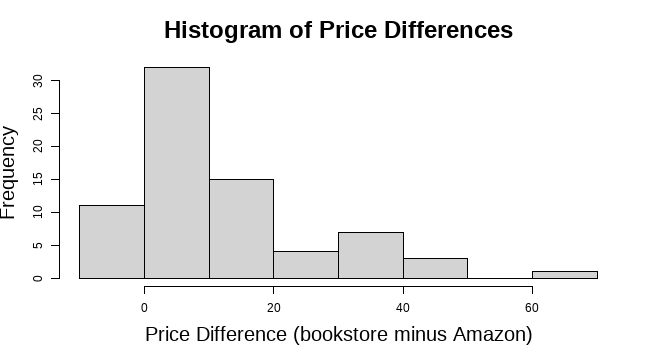<!-- --> ] .pull-right[ ```r qqnorm(textbooks$diff) qqline(textbooks$diff) ``` 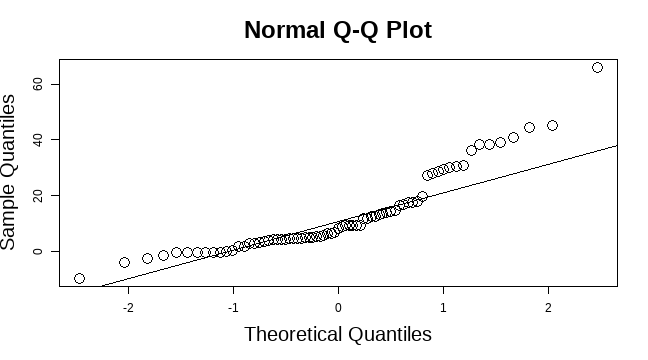<!-- --> ] --- # Paired `\(t\)`-Test: Check Conditions! (line ~145) .pull-left[ <!-- --> ] .pull-right[ <!-- --> ] Do the differences seem to come from a normally-distributed population? -- **NOPE.** But, there are 73 of them, so we can use the central limit theorem to say `\(\bar{x}_{\text{diff}}\)` is nearly normal, which is good enough. --- # Paired `\(t\)`-Test (line ~157) We want to know if there's a *difference* between the prices, on average. `$$H_0: \ \mu_{\text{diff}} = 0 \quad \text{vs.} \quad H_{a}: \ \mu_{\text{diff}} \neq 0,$$` Same "machinery" as a one-population mean `\(t\)`-test, just using *differences*. ```r *t.test(textbooks$diff, mu = 0, alternative = "two.sided") ``` ``` One Sample t-test data: textbooks$diff t = 7.6488, df = 72, p-value = 6.928e-11 alternative hypothesis: true mean is not equal to 0 95 percent confidence interval: 9.435636 16.087652 sample estimates: mean of x 12.76164 ``` --- # Difference of Two Means: `\(\mu_1 - \mu_2\)` - Read in the penguin data on line ~165 - Remember this bimodal histogram from last week? (line ~171) <img src="lab12-slides-sync_files/figure-html/penguinsHist-1.png" style="display: block; margin: auto;" /> --- # Difference of Two Means: `\(\mu_1 - \mu_2\)` .pull-left[ ```r hist(penguins$flipper_length_mm, main = "Histogram of Flipper Length", xlab = "Flipper length (mm)", col = "peachpuff") ``` 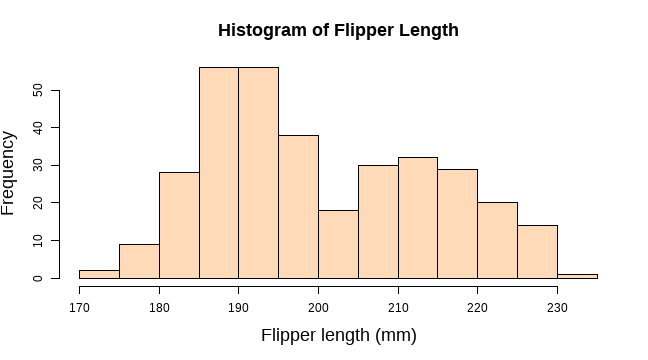<!-- --> ] .pull-right[ - Bimodal distributions suggest a **subgroup effect** - There are *three different species* in this data .bg-washed-yellow.b--yellow.navy.ba.bw2.ph4[ .b[TASK:] Take 2 minutes to write code in the `investigateSpecies` chunk (line 182) to investigate the relationship between species and flipper length. ] ] --- # Difference of Two Means: `\(\mu_1 - \mu_2\)` .pull-left[ ```r boxplot(flipper_length_mm ~ species, data = penguins, xlab = "Penguin Species", ylab = "Flipper Length (mm)", main = "Boxplots of Flipper Length by Species") ``` 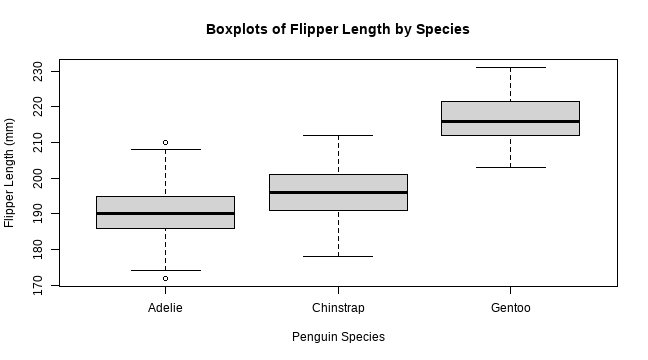<!-- --> ] .pull-right[ 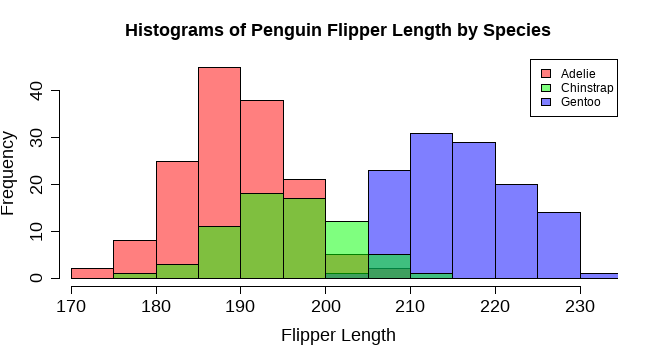<!-- --> (code for this histogram is available on request; it's a little too ugly to show) ] --- # Difference of Two Means: `\(\mu_1 - \mu_2\)` Let's just compare mean flipper lengths of Adelie and Chinstrap penguins -- the Gentoos are obviously different, so why bother. **Hypotheses?** (line ~188) -- `$$H_0: \mu_{\text{Adelie}} - \mu_{\text{Chinstrap}} = 0 \quad \text{vs.} \quad H_{a}: \mu_{\text{Adelie}} - \mu_{\text{Chinstrap}} \neq 0$$` -- Subset the data to contain just Adelies and Chinstraps (line ~197) ```r penguinsSubset <- subset(penguins, species %in% c("Adelie", "Chinstrap")) table(penguinsSubset$species) ``` ``` Adelie Chinstrap 146 68 ``` --- # Difference of Two Means: `\(\mu_1 - \mu_2\)` .bg-washed-yellow.b--yellow.navy.ba.bw2.ph4[ The most important question in statistics is not whether you .b[can] do something, it's whether you .b[should] do it. ] ## Check Conditions! -- 1. **Independence**: 1. Penguins *within* each species are selected independently 1. The samples from each species (*between* samples) are independent 1. **Nearly Normal**: 1. Adelie flipper lengths are nearly normal 1. Chinstrap flipper lengths are nearly normal --- # Difference of Two Means: Check Normality ```r *qqnorm(penguinsSubset$flipper_length_mm[penguinsSubset$species == "Adelie"], main = "Normal Q-Q Plot for Adelie Penguins") qqline(penguinsSubset$flipper_length_mm[penguinsSubset$species == "Adelie"]) *qqnorm(penguinsSubset$flipper_length_mm[penguinsSubset$species == "Chinstrap"], main = "Normal Q-Q Plot for Chinstrap Penguins") qqline(penguinsSubset$flipper_length_mm[penguinsSubset$species == "Chinstrap"]) ``` <img src="lab12-slides-sync_files/figure-html/twoSampleNormalReal-1.png" style="display: block; margin: auto;" /> --- # Two-Sample `\(t\)`-Test Remember formula notation: > (response variable) **~** (grouping/explanatory variable) ```r *t.test(flipper_length_mm ~ species, data = penguinsSubset, mu = 0, alternative = "two.sided") ``` ``` Welch Two Sample t-test data: flipper_length_mm by species t = -5.6115, df = 120.88, p-value = 1.297e-07 alternative hypothesis: true difference in means is not equal to 0 95 percent confidence interval: -7.739129 -3.702450 sample estimates: mean in group Adelie mean in group Chinstrap 190.1027 195.8235 ``` What's our conclusion? --- class: inverse # Code Cheat Sheet 💻 ### **`pt(q, df, lower.tail = TRUE)`** - `q` is the x-axis value you want to find an area related to - `df` is the degrees of freedom of the `\(t\)` distribution - `lower.tail` determines whether `pt()` finds the area to the left or right of `q`. If `lower.tail = TRUE` (the default), it shades to the left. If `lower.tail = FALSE`, it shades to the right. --- class: inverse # Code Cheat Sheet 💻 ### **`qt(q, df, lower.tail = TRUE)`** - `p` is the probability or area under the curve you want to find an x-axis value for - `df` is the degrees of freedom of the `\(t\)` distribution - `lower.tail` determines whether `pt()` finds the area to the left or right of `q`. If `lower.tail = TRUE` (the default), it shades to the left. If `lower.tail = FALSE`, it shades to the right. --- class: inverse # Code Cheat Sheet 💻 ### **`plotT()`** - `df` refers to the degrees of freedom of the distribution to plot. You must provide this value. - `shadeValues` is a vector of up to 2 numbers that define the region you want to shade - `direction` can be one of `less`, `greater`, `outside`, or `inside`, and controls the direction of shading between `shadeValues`. Must be `less` or `greater` if `shadeValues` has only one element; `outside` or `inside` if two - `col.shade` controls the color of the shaded region, defaults to `"cornflowerblue"` - `...` lets you specify other graphical parameters to control the appearance of the normal curve (e.g., `lwd`, `lty`, `col`, etc.) --- class: inverse # Code Cheat Sheet 💻 ### **`qqnorm(y, ...)`** - `y` refers to the variable for which you want to create a Q-Q plot - `...` lets you control graphical elements of the plot like `pch`, `col`, etc. ### **`qqline(y, ...)`** - `y` refers to the variable for which you created a Q-Q plot - `...` lets you control graphical elements of the plot like `pch`, `col`, etc. - Function can only be used *after* using `qqnorm()` --- class: inverse # Code Cheat Sheet 💻 ### **`t.test(x, alternative = c("two.sided", "less", "greater"), mu = 0, conf.level = 0.95)`** - `x` is a vector of data values OR a formula of the form *response ~ group* for two-sample t-tests. - `alternative` specifies the direction of the alternative hypothesis; must be one of "two.sided", "less", or "greater" - `mu` indicates the true value of the mean (under the null hypothesis); defaults to 0 - `conf.level` is the confidence level to be used in constructing a confidence interval; must be between 0 and 1, defaults to 0.95 --- class: inverse # Lab Project ⌨️ .pull-left[ ### Your tasks - Complete the "Try It!" and "Dive Deeper" portions of the lab assignment by copy/pasting and modifying appropriate code from earlier in the document. - Introduce yourself to your collaborators - **Do not leave people behind.** ] .pull-right[ ### How to get help - Ask your collaborators -- share your screen! - Use the "Ask for Help" button to flag me down. ] --- class: center, middle # How'd it go? Questions? ### http://bit.ly/250ticket12 --- class: center middle # Reminders 💡 Your tasks for the week running Friday 11/13 - Friday 11/20 | Task | Due Date | Submission | |:-----|:---------|:-----------| | M-Write 2 Revision | Thursday 11/19 4:59PM ET| Canvas | | Lab 12 | Friday 11/20 8:00AM ET | Canvas | | Homework 9 | Friday 11/20 8:00AM ET | course.work | *M-Write Office Hours on Canvas!*